From the Library - Len Mullenger
Mrs
Delany
The Autobiography and correspondence of Mary Granville Delany ed.
Lady Llanover. 3 vols 1861
Sunday
25th September 2011 proved a difficult day for one of our newest and
youngest guides as she had been faced with a number of very difficult
questions from visitors such as "How heavy are the library doors?"
She was also asked what she knew about Mrs Delany. As she had never
heard of Mrs Delany she was unable to give an answer only to be told
"but you have three books by her in the library". The hapless
volunteer passed the question on to myself and Rita Haigh but we too
had to confess that we had not heard of her. We gave a wry smile at
the thought that because the books were in the library we must have
had access to them and might have read them! There the matter may
have rested except that on the following Wednesday I went to the Farewell
Party for Christine Haywood. I was talking to another volunteer,Margaret
Thompson, about the articles I had been writing on the books in the
library to be told that she was very interested in Mrs Delany. As
this was the second time her name had been mentioned in a week I thought
I had better find out who this person was - thank goodness for Google
and Wikipedia!. I could not even find the books in the Library but
Julie Griffith managed to locate them for me.
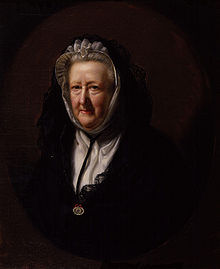
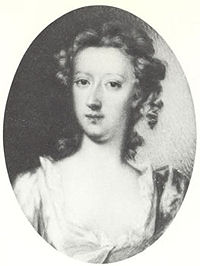 Mary
Delany (nee Granville) (14 May 1700 – 15 April 1788)
Mary
Delany (nee Granville) (14 May 1700 – 15 April 1788)
(Left) Mary Delany, from an enamel, possibly by the painter, Barber,
whose career Mrs Delany was eager to promote.
(Right) Painting John Opie, Mary Granville, Mrs. Delany, 1782 Oil
on canvas, The Royal Collection
Mary
Delany was born in Coulston, Wiltshire. Her parents were Colonel Bernard
Granville and Mary Granville and she was niece to George Granville,
1st Baron Lansdowne. Her parents moved to London and Mary was sent
to live with her aunt, Lady Stanley. The plans were for her to become
a Lady in Waiting but this was prevented by the death of Queen Anne
in 1714. The Granvilles then moved to Buckland in Gloucestershire.
Mary was an excellent "amateur" artist and also mastered
the arts of japanning, silhouettes and embroidery. She had also developed
the art of paper cutting at which she became exceedingly skilled.
Lord Lansdowne introduced Mary to Alexander Pendarves MP and a marriage
was arranged for February 1718. Pendarves was 60 whilst Mary was just
17. Her parents approved of the marriage as it brought them financial
stability and, 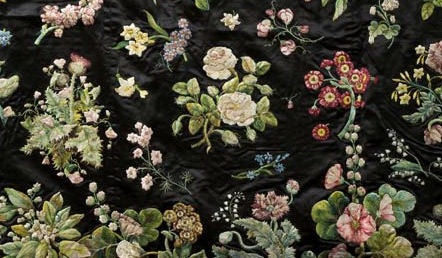 through
the marriage Lord Lansdowne, hoped to gain more political influence.
She was not happily married and her husband drank a great deal and
he died suddenly in 1724 when Mary was still only 24. However she
failed to inherit the estate because Alexander Pendarves had never
altered his will in her favour. During her marriage she had designed
and embroidered a stunning court dress, an intricate and delicate
floral on black satin—in this work we can see the beginnings
of her later masterful collages (left).
through
the marriage Lord Lansdowne, hoped to gain more political influence.
She was not happily married and her husband drank a great deal and
he died suddenly in 1724 when Mary was still only 24. However she
failed to inherit the estate because Alexander Pendarves had never
altered his will in her favour. During her marriage she had designed
and embroidered a stunning court dress, an intricate and delicate
floral on black satin—in this work we can see the beginnings
of her later masterful collages (left).
Because she had
no home of her own she resorted to living with friends and relatives
and so was able to pursue a social life. She was pretty and witty
and had a great many suitors but ignored them all for 20 years. After
Alexander's death, Mary lived with her aunt and uncle, Lord and Lady
Stanley. Mary had a good education being able to speak French and
had also had the fortune to meet Alexander Pope, Jonathan Swift, the
composer George Frederic Handel, John Wesley and Samuel Johnson. After
her aunt's death, Mary spent time in Ireland with the family of her
friend Mrs Donellan. In Ireland she met a clergyman, Dr Patrick Delany
and in 1743, at the age of 43, she married him for love; Delaney was
59. They lived in Dublin and both were very interested in Botany and
gardening. Dr Delany encouraged her skills in gardening, painting,
shell-work and needlework and flowers were usually the theme. Delany
died in 1768 so Mary again became a widow at the age of 68.
Mary then spent
much of her time with a close friend, Margaret Bentinck, Dowager Duchess
of Portland. Both were keen Botanists and got to know Joseph Banks
and Daniel Solander. She was also introduced to George III and Queen
Charlotte. The Duchess employed entomologists, botanists and ornithologists
and the estate housed a zoo, aviary and botanical garden. Mary became
very skilled at depicting flowers using cut paper (decoupage). She
turned this into an art form. "For these 'mosaicks' are coloured
paper representing not only conspicuous details but also contrasting
colours or shades of the same colour so that every effect of light
is caught" Her cutouts were very detailed and botanically correct.
She would cut minute particles of colored paper to represent the petals,
stamens, calyx, leaves, veins, stalk and other parts of the plant,
and using lighter and darker paper to form the shading. She would
then glue the cut paper pieces on to a black paper background. It's
uncertain what kind of glue she used, but it was probably egg-white
or flour and water. She made 1700 of them before her eyesight failed
when she reached 88; they filled 10 volumes of her Flora. They are
still held in the British museum and referred to as the Flora
Delanica. Joseph Banks said her mosaicks were the only imitations
of nature that he had ever seen, from which he could venture to describe
botanically any plant without the least fear of committing an error.
Queen Charlotte
was very interested in Mary's paper cutting and when Margaret Bentinck
died Mary was given both a house in Windsor as well as an annual pension
by Queen Charlotte.
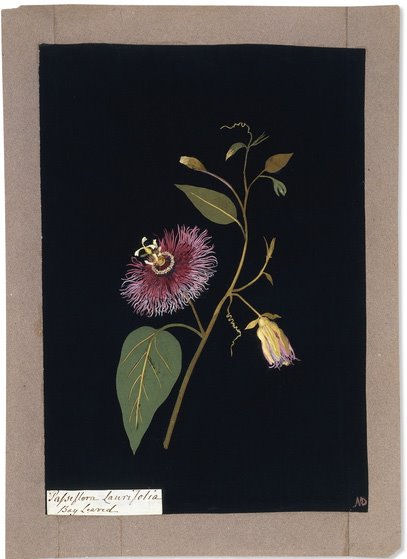
"Passeflora
Laurifolia, Bay Leaved"...there are over 230 paper petals
in the bloom. |
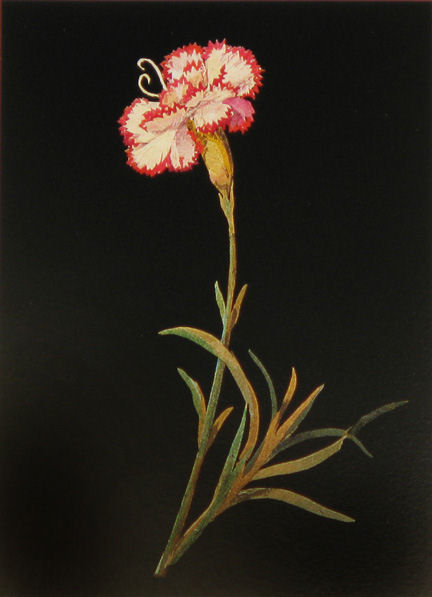
Dianthus caryophyllus
|
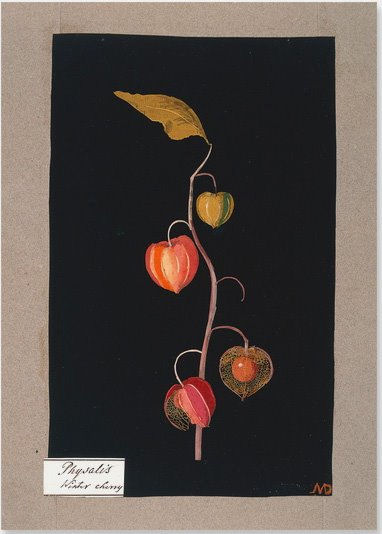
"Physalis,
Winter Cherry" |
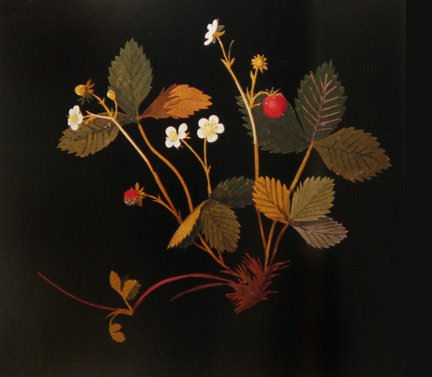
"Fragaria
Vesca, wood strawberry" |
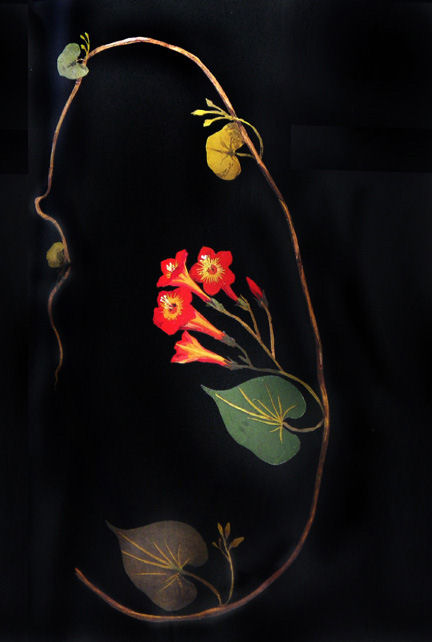
Ipomea Coccinea
|
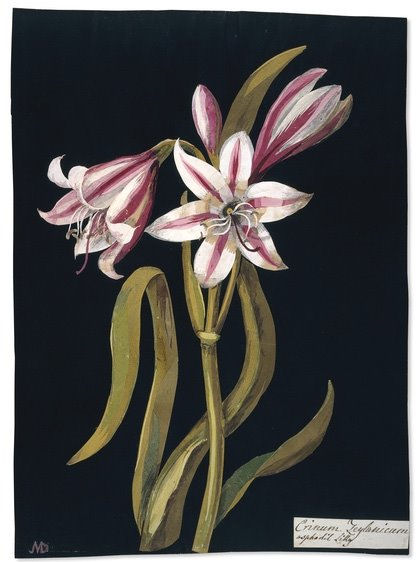
"Crinum
Zeylanicum, Asphodil Lilly" |
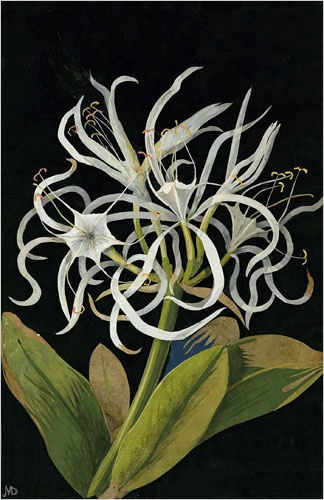
Pancratium
Maritinum |
 |
Available on-line The full text of
Mrs
Delany (Mary Granville): a memoir. 1700-1788
Len Mullenger is a Sunday volunteer guide. Any comments
are welcome and can be sent to len@musicweb-international.com

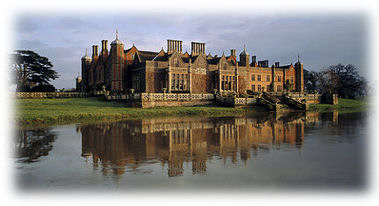

 Mary
Delany (nee Granville) (14 May 1700 – 15 April 1788)
Mary
Delany (nee Granville) (14 May 1700 – 15 April 1788)  through
the marriage Lord Lansdowne, hoped to gain more political influence.
She was not happily married and her husband drank a great deal and
he died suddenly in 1724 when Mary was still only 24. However she
failed to inherit the estate because Alexander Pendarves had never
altered his will in her favour. During her marriage she had designed
and embroidered a stunning court dress, an intricate and delicate
floral on black satin—in this work we can see the beginnings
of her later masterful collages (left).
through
the marriage Lord Lansdowne, hoped to gain more political influence.
She was not happily married and her husband drank a great deal and
he died suddenly in 1724 when Mary was still only 24. However she
failed to inherit the estate because Alexander Pendarves had never
altered his will in her favour. During her marriage she had designed
and embroidered a stunning court dress, an intricate and delicate
floral on black satin—in this work we can see the beginnings
of her later masterful collages (left). 






